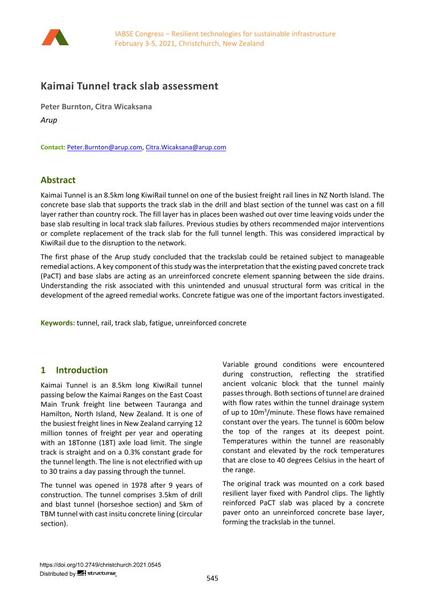Kaimai Tunnel track slab assessment

|
|
|||||||||||
Bibliografische Angaben
| Autor(en): |
Peter Burnton
(Arup)
Citra Wicaksana (Arup) |
||||
|---|---|---|---|---|---|
| Medium: | Tagungsbeitrag | ||||
| Sprache(n): | Englisch | ||||
| Tagung: | IABSE Congress: Resilient technologies for sustainable infrastructure, Christchurch, New Zealand, 3-5 February 2021 | ||||
| Veröffentlicht in: | IABSE Congress Christchurch 2020 | ||||
|
|||||
| Seite(n): | 545-553 | ||||
| Anzahl der Seiten (im PDF): | 9 | ||||
| DOI: | 10.2749/christchurch.2021.0545 | ||||
| Abstrakt: |
Kaimai Tunnel is an 8.5km long KiwiRail tunnel on one of the busiest freight rail lines in NZ North Island. The concrete base slab that supports the track slab in the drill and blast section of the tunnel was cast on a fill layer rather than country rock. The fill layer has in places been washed out over time leaving voids under the base slab resulting in local track slab failures. Previous studies by others recommended major interventions or complete replacement of the track slab for the full tunnel length. This was considered impractical by KiwiRail due to the disruption to the network. The first phase of the Arup study concluded that the trackslab could be retained subject to manageable remedial actions. A key component of this study was the interpretation that the existing paved concrete track (PaCT) and base slabs are acting as an unreinforced concrete element spanning between the side drains. Understanding the risk associated with this unintended and unusual structural form was critical in the development of the agreed remedial works. Concrete fatigue was one of the important factors investigated. |
||||
| Stichwörter: |
Ermüdung Schiene Tunnel
|
||||
